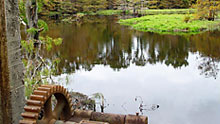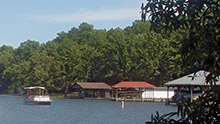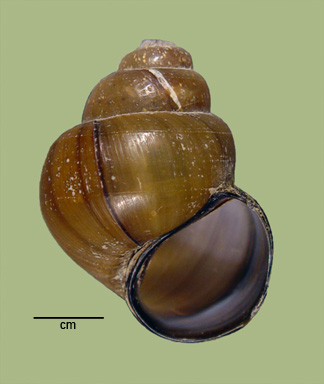“Bellamya” chinensis, C. malleata
> Habitat & Distribution
Cipangopaludina chinensis populations are widely introduced throughout the United States, especially in northern latitudes, extending into Canada (Clench & Fuller 1965, Clarke 1981, Jokinen 1982). The ANSP holds quite a few lots collected in the 1950s and 1960s from southeastern Pennsylvania. As of 2018 we were aware of approximately 50 populations in our study area, roughly half In Atlantic drainages and half in drainages of The Ohio, generally inhabiting ponds, lakes, reservoirs, and larger rivers. Cipangopaludina seems to reach the limit of its range in eastern (glaciated) Nebraska, apparently excluded from the dryer Great Plains further west.
We have no confirmed records of C. chinensis south of the vicinity of Louisville, KY. The earliest reports of Cipangopaludina in the eastern United States were, however, records of “Viviparus” or Cipangopaludina chinensis populations in Alamance and Pitt Counties, North Carolina from the 1940s (Clench & Fuller 1965), with a Wake County record added in 1977 (Cordiero, pers. comm). Directed searches conducted 2011-12 failed to confirm Cipangopaludina populations (of any species) at any of these sites - Alamance, Pitt or Wake. Nor have we been able to confirm two subsequent records of C. chinensis from Virginia (Stewart & Dillon 2004), although C. japonica is not uncommon in the Old Dominion. We suspect that all of these older records from the South may arise from chinensis/japonica confusion. FWGNA incidence rank I-4.
> Ecology & Life History
We are not aware of any ecological differences between C. chinensis and the (very similar) C. japonica, which may have been introduced into North America simultaneously, and occasionally occur in mixed populations. See our Cipangopaludina japonica page for more detailed discussion of the ecology, origin and spread of Cipangopaludina in North America.
The (surprisingly sparse) life history studies of C. chinensis suggest that maturity may be reached at age one year, with iteroparous reproduction for several years thereafter (Life cycle G, Stanczykowska et al 1971, Jokinen 1982, Therriault & Kott, 2002). Jokinen’s (1987) analysis of the distribution of C. chinensis in Connecticut and New York led her to classify it as a “C-D tramp,” potentially present in nearly every community. Dillon’s (2000) reanalysis of these data suggested that C. chinensis populations in Connecticut seem to be Undifferentiated with respect to life history adaptation.Cipangopaludina populations sometimes seem to reproduce explosively, then suffer dramatic crashes, as might be associated with semelparous reproduction (see my essay of 5Aug14 below). The adult population of C. chinensis inhabiting a 1.46 ha New York pond increased from approximately N = 150 in the sampling season of 2010 to N = 1000 in 2012 (McCann 2014). Chaine and colleagues (2012) estimated an adult population size of 253,570 in a 6.47 ha Nebraska reservoir, with a 1:1 sex ratio and an estimated fecundity of 27.2 - 33.3 young per female per year (Stephen et al. 2013). The following year, 39% of the population died (Haak et al. 2013).
Such dramatic population fluctuations might be a natual consequence of spent-salmon semelparity. We think invasive flush-crash population dynamics are more likely, however, initial blooms leading to the colonization of marginal habitats, and consequent die-offs as resources are depleted.
The ecological consequences of Cipangopaludina invasion are difficult to document. Johnson et al. (2009) reported some experimental evidence that Cipangopaludina invasion might have a negative impact on native populations of pulmonate snails, although this was not confirmed by field surveys (Solomon et al. 2010). In Japan, where Cipangopaludina is harvested for human consumption, concern has been expressed that rice paddy populations of C. chinensis may be decreasing (Nakanshi et al. 2014).
Huehner and Etges (1977) reported the development of the trematode Aspidogaster conchicola - typically considered a bivalve parasite - in an Ohio population of "Viviparus malleatus." Harried et al (2015) reported rather strikingly low rates of trematode parasitism rates in 22 Wisconsin lakes, however.
Prezant et al. (2006) found evidence that populations of C. chinensis in New Jersey may react to crayfish predation by producing larger numbers of offspring, smaller and more variable in size.
> Taxonomy & Systematics
See under C. japonica for notes regarding the generic taxonomy. Up until 2021 the FWGNA project followed Smith (2000) in assigning both of the large oriental viviparids invasive here in North America to the genus Bellayma. More recently, the DNA sequence data developed by Stelbrink et al. (2020) have suggested their reassignment back to Cipangopaludina, leaving Bellamya as a genus for African species. See my essay of 9Mar21 from the link below.
Reeve (1863) described Paludina malleatus without distinguishing it from J. E. Gray’s (1834) P. chinensis, or indeed from any other oriental viviparid. Clench & Fuller (1965) considered malleata (Reeve) a subspecies of chinensis, again without distinguishing it from chinensis (s.s.). We follow Smith (2000) subsuming malleata (Reeve) under chinensis (Gray) entirely.
> Supplementary Resources
- Cipangopaludina distribution in Atlantic drainages (2023)
- Cipangopaludina in the drainages of The Ohio (2019)
- The viviparids of The Great Plains (2024)
> Essays
- Cipangopaludina was mentioned parenthetically in my 29Oct03 essay on Invasive Viviparids in South Carolina. The distributional info is a bit obsolete, but there are several additional photos.
- See my Bellamya News of 6Oct05 for items about Cipangopaludina Ranching in North Carolina, Cipangopaludina Roundup in Massachusetts, and Cipangopaludina as a Model for Invertebrate Anatomy.
- The Community Consequences of Bellamya Invasion in Wisconsin lakes were explored in my FWGNA blog post of 18Dec09. There was also a nice photo comparing C. chinensis to C. japonica, both juvenile and adult.
- My FWGNA blog post of 12Sept11, Dispatches from the Viviparid Front, included one item on a citizen's monitoring effort in Wisconsin (with links to some good references) and a second item on controlling C. chinensis in Ontario by hand-picking.
- In Just Before The Bust (5Aug14) I described a Cipangopaludina japonica population explosion in the tailwaters of the the Wateree Dam in central South Carolina. That post featured several striking in situ photos, including a high resolution jpeg of a "bed" of Cipangopaludina apparently filter feeding like mussels.
- I reviewed the Cipangopaludina records in the USGS Nonindigenous Aquatic Species database in my post of 16Oct15, To Only Know Invasives. That essay featured two photos of C. chinensis shells, one of which was incorrectly labeled japonica by the USGS.
- Unsurprisingly, Cipangopaludina of many species are widely retailed through the online aquarium trade. See my post of 24Jan18, Snails by Mail.
- I reviewed A Gene Tree for the Worldwide Viviparidae published by Stelbrink et al. (2020) in my post of 9Mar21. That essay focused on the question of genus assignment for our big oriental viviparids here in North America, Cipangopaludina or Bellamya?
> References
Burnett, J.L., and six colleagues
(2018) Thermal tolerance limits of the Chinese
mystery snail (Bellamya
chinensis): implications for management.
American Malacological Bulletin 36: 140 - 144.
Chaine,
N. M., C. Allen, K. Fricke, D. Haak,
M. Hellman,
R. Kill, K. Nemec, K. Pope, N. Smeenk, B. Stephen, D. Uden, K.
Unstad & A. VanderHam (2012)
Population estimate of Chinese mystery snail (Bellamya chinensis)
in a Nebraska reservoir. BioInvasions Records 1: 283-287.
Clarke, A. (1978) The Asian apple snail, Cipangopaludina
chinensis (Viviparidae) in Oneida Lake, New York. The
Nautilus, 92:134.
Clarke, A. H. (1981) The
Freshwater Mollusks of Canada. The National Museums of
Canada, Ottawa.
Clench, W. & Fuller, S. (1965) The
genus Viviparus
in North America. Occas. Pprs. on Mollusks, Mus. Comp. Zool. Harvard,
2, 385-412.
Cordeiro, J. R. (2002) Proliferation of
the Chinese mystery snail, Cipangopaludina chinensis malleata
(Reeve, 1863) throughout Connecticut [Abstract]. Program and Abstracts
of the 68th Meeting of the American Malacological Society, Charleston,
SC (R. T. Dillon, ed.) p. 37.
Dillon, R. T., Jr. (2000) The
Ecology of Freshwater Molluscs. Cambridge University Press,
Cambridge, England. 509 pp.
Gray, J. E. (1834)
Paludina chinensis.
Pg 599 and Plate IV in Cuvier’s Animal Kingdom, Volume
12, Mollusca and Radiata (E. Griffith & E. Pidgeon,
eds.) Whittaker & Co, London.
Harried, B., K. Fischer,
K.E. Perez, and G.J. Sandland (2015) Assessing
infection patterns in Chinese mystery snails from Wisconsin, USA using
field and laboratory approaches. Aquatic Invasions
10(2):169-175.
Havel, J.E. (2011) Survival of the
exotic Chinese mystery snail (Cipangopaludina
chinensis malleata) during air exposure and implications
for overland dispersal by boats. Hydrobiologia
668(1):195-202.
Huehner, M. K. & F. J. Etges (1977) The
life cycle and development of Aspidogaster conchicola in the snails, Viviparus malleatus
and Goniobasis livescens.
Journal of Parasitology 63: 669 - 674.
Johnson, P., Olden, J., Solomon, C. & Vander
Zanden, M. (2009)
Interactions among invaders: community and ecosystem effects of
multiple invasive species in an experimental aquatic system. Oecologia,
159:161-170.
Jokinen, E. (1982) Cipangopaludina
chinensis (Gastropoda: Viviparidae) in North America.
Nautilus 96: 89 – 95.
Jokinen, E. (1983)
The freshwater snails of Connecticut. State Department of
Environmental Protection Bulletin 109, 83 pp.
Jokinen, E. (1987) Structure
of freshwater snail communities: Species-area relationships and
incidence categories. Amer. Malac. Bull. 5: 9 - 19.
Haak, D. M., N. M. Chaine, B. J. Stephen, A. Wong, & C. R.
Allen (2013) Mortality estimate of Chinese
mystery snail, Bellamya
chinensis in a Nebraska reservoir. BioInvasions
Records 2: 137-139.
Havel,
J.E. (2011) Survival of the exotic
Chinese mystery snail (Cipangopaludina
chinensis malleata) during air exposure and implications
for overland dispersal by boats. Hydrobiologia
668(1):195-202.
Khan, R., & S. Chaudhuri (1984)
The population and production ecology of a freshwater snail Bellamya
bengalensis (Lamarck) (Gastropoda: Viviparidae) in an
artificial lake of Calcutta, India. Bull. Zool. Surv. India, 5: 59-76.
McCann, M.J. (2014)
Population dynamics of the non-native freshwater gastropod, Cipangopaludina chinensis
(Viviparidae): A capture-mark-recapture study. Hydrobiologia
730: 17-27.
Nakanishi, K., K-I.
Takakura, R. Kanai, K. Tawa, D. Murakami and H. Sawada (2014)
Impacts of environmental factors in rice paddy fields on abundance of
the mud snail (Cipangopaludina
chinensis laeta). Journal of Molluscan
Studies 80(4):460-463.
Prezant, R. S., E. J. Chapman & A. McDougall (2006) In
utero predator-induced responses in the viviparid snail Bellamya chinensis.
Can. J. Zool. 84: 600-608.
Raut, S. (1986) Inhibition of fish growth
by the freshwater snail Bellamya
bengalensis. Environ. Ecol., 4: 332-333.
Reeve, L. A. (1863)
Monograph of the genus Paludina.
Conchologica Iconica Volume 14 (1864), unpaginated. Lovell
Reeve & Co, London.
Smith, D.G. (2000) Notes on the taxonomy
of introduced
Bellamya
(Gastropoda: Viviparidae) species in northeastern North
America. Nautilus 114: 31-37.
Solomon, C., Olden, J., Johnson, P., Dillon, R. &
Vander Zanden, M. (2010) Distribution and
community-level effectsof the Chinese mystery snail (Bellamya
chinensis) in northern Wisconsin lakes. Biological
Invasions, 12:1591-1605. [PDF]
Stanczykowska, A., Magnin, E. & Dumouchel, A.
(1971) Etude de trois populations de Viviparus
malleatus
(Reeve) de la region de Montreal. I. Croissance, fecondite, biomasse et
production annuelle. Canadian Journal of Zoology,
49:1431-1441.
Stelbrink,
B., R. Richter, F. Köhler, F. Riedel, E. Strong, B. Van Bocxlaer, C.
Albrecht, T. Hauffe, T. Page, D. Aldridge, A. Bogan, L-N. Du, M.
Manuel-Santos, R. Marwoto, A Shirokaya, and T. Von Rintelen
(2020) Global diversification dynamics since
the
Jurassic: Low dispersal and habitat-dependent evolution explain
hotspots of diversity and shell disparity in river snails
(Viviparidae). Systematic Biology 69: 944 – 961.
Stephen,
B.J., C.R. Allen, N.M. Chaine, K.A. Fricke, D.M. Haak, M.L. Hellman,
R.A. Kill, K.T. Nemec, K.L. Pope, N.A. Smeenk, D.R. Uden, K.M. Unstad,
A.E. Van der Ham, and A. Wong (2013) Fecundity of
the Chinese mystery snail in a Nebraska reservoir. Journal of
Freshwater Ecology 28(3):439-444.
Stewart, T. & Dillon, R. (2004)
Species
composition and geographic distribution of Virginia's freshwater
gastropod fauna: A review using historical records. American
Malacological Bulletin, 19:79-91.
Therriault, T. & Kott, E. (2002-3)
Cipangopaludina chinensis malleata
(Gastropoda: Viviparidae) in southern Ontario: An update of the
distribution and some aspects of life history. Malacological Review,
35-36:111-121.
Zhu, J., K. Lu &
X. Liu (2013) Can the freshwater snail Bellamya aeruginosa
affect phytoplankton community and water quality?
Hydrobiologia 707: 147-157.








